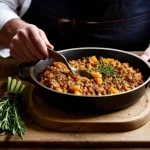Essential Spices and Their Roles in Mulligatawny Soup
Understanding mulligatawny soup spices is key to crafting an authentic mulligatawny flavor that delights the palate. The traditional Indian spices at the heart of this dish include coriander, cumin, turmeric, black pepper, cardamom, cloves, cinnamon, and fenugreek.
Each spice plays a specific role in balancing the soup’s complex profile. Coriander adds a citrusy brightness, while cumin delivers earthy warmth. Turmeric offers vibrant color and subtle bitterness, complementing the mild heat from black pepper. The sweet, aromatic qualities of cardamom, cloves, and cinnamon introduce depth and an inviting fragrance. Fenugreek contributes subtle bitterness that rounds out the flavors without overpowering.
Also to see : Why Do Traditional UK Recipes Hold Timeless Culinary Value?
Choosing between whole and ground spices impacts the depth and aroma significantly. Whole spices release their oils slowly during cooking, infusing the soup with nuanced aromas. Ground spices, by contrast, disperse flavor quickly but may lose complexity if cooked too long. For authentic mulligatawny soup spices, starting with whole spices and toasting or blooming them before adding enhances the dish’s richness and authenticity. This careful use of spices ensures the soup delivers a vibrant, well-rounded taste that reflects its Indian culinary roots.
Proven Spice Layering and Cooking Techniques
Mastering layering spices is essential to unlock the full potential of mulligatawny soup spices. One crucial technique is blooming spices, where whole or ground spices are briefly toasted or cooked in hot oil at the beginning of the cooking process. This releases their essential oils, intensifying aroma and deepening flavor. Blooming ensures that spices like cumin, cardamom, and cloves infuse the soup thoroughly rather than tasting flat.
Topic to read : What Are the Historical Roots of Traditional UK Dishes?
Timing is key during mulligatawny soup preparation. Early addition of whole spices allows gradual oil release, subtly enhancing the broth’s complexity. Ground spices, due to their faster flavor dispersal, should be added later to avoid bitterness from overcooking. For example, turmeric is often added mid-cooking to preserve its vibrant color and delicate taste, while black pepper can be stirred in closer to the end to maintain its pungency.
Professional chefs emphasize maintaining moderate heat during bloom to avoid scorching spices, which can lead to acrid flavors. Stirring continuously and watching for aromatic cues provides a practical way to gauge optimal spice toasting.
By layering spices thoughtfully and applying precise timing, mulligatawny soup preparation achieves a harmonious and dynamic flavor profile, reflecting its Indian culinary roots with clarity and balance.
Perfecting the Spice Blend: Proportions and Ingredient Substitutions
Achieving an authentic mulligatawny flavor hinges on precise spice proportions. Typically, a balanced blend includes coriander and cumin as the base, with turmeric adding color and fenugreek contributing subtle bitterness. For example, a common ratio might be 2 parts coriander to 1 part cumin, ½ part turmeric, and a pinch of fenugreek. Black pepper, cardamom, cloves, and cinnamon are used sparingly to avoid overpowering the palate but remain crucial for aromatic depth.
Adjusting the spice blend to suit dietary preferences or ingredient availability is practical without sacrificing flavor complexity. For instance, if fenugreek is unavailable, a small amount of mustard seeds can provide a similar bitterness. Similarly, when cardamom pods are hard to find, ground cardamom can substitute, though it requires careful measurement to prevent intensity.
Those concerned about heat can slightly reduce black pepper while increasing aromatic spices like cinnamon or cloves. This maintains the characteristic warmth and fragrant profile of mulligatawny soup spices without excessive spiciness.
By understanding the proportions and wise substitutions, cooks can customize the classic traditional Indian spices in mulligatawny soup, crafting a blend that respects authenticity yet adapts to individual tastes and ingredient constraints.
Cultural and Historical Insights into Mulligatawny Spicing
Mulligatawny soup’s origin traces back to Indian-British cuisine history, emerging during the colonial era when British tastes met traditional Indian flavors. The name itself derives from the Tamil words “milagu” (pepper) and “tanni” (water), reflecting its peppery broth base. Understanding this history is key to appreciating the distinctive mulligatawny soup spices.
Regional variations shaped the spice profile over time. South Indian influences contributed the use of mustard seeds and curry leaves, while northern adaptations favored warming spices like cinnamon and cardamom. These evolving interpretations demonstrate how mulligatawny soup embraces diverse traditional Indian spices, each bringing unique aromatic and flavor contributions to the dish.
Culturally, spices such as fenugreek and cloves hold symbolic and practical significance. Fenugreek’s slight bitterness balances richer ingredients, and cloves add warmth and complexity, often associated with festive Indian cooking. This layering of meaning illustrates that the authentic mulligatawny flavor is not merely culinary but embedded in cultural context.
Recognizing these historical and cultural dimensions enriches mulligatawny soup preparation, offering a deeper connection to its roots while honoring the intricate spice layering that defines this classic dish.

